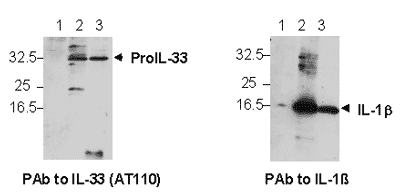Product Details
| Alternative Name: | Interleukin-33, NF-HEV, IL-1F11 |
| |
| Host: | Rabbit |
| |
| Immunogen: | Recombinant human soluble IL-33 (interleukin-33) (aa 112-270) (Prod. No. ALX-522-098). |
| |
| UniProt ID: | O95760 |
| |
| Gene/Protein Identifier: | 90865 (Entrez GeneID), 608678 (OMIM) |
| |
| Source: | Purified from rabbit serum. |
| |
| Species reactivity: | Human, Mouse, Rat
|
| |
| Specificity: | Recognizes pro-IL-33 and mature IL-33. |
| |
| Applications: | ELISA, WB
|
| |
| Recommended Dilutions/Conditions: | Western Blot (1:1,000)
Suggested dilutions/conditions may not be available for all applications.
Optimal conditions must be determined individually for each application. |
| |
| Positive Control: | Prod. No. ALX-522-098; Prod. No. ALX-522-101 |
| |
| Purity Detail: | Protein A-affinity purified. |
| |
| Formulation: | Liquid. In PBS containing 0.02% sodium azide. |
| |
| Use/Stability: | Stable for at least 1 year after receipt when stored at -20°C. |
| |
| Handling: | Avoid freeze/thaw cycles. After opening, prepare aliquots and store at -20°C. |
| |
| Shipping: | Blue Ice |
| |
| Short Term Storage: | +4°C |
| |
| Long Term Storage: | -20°C |
| |
| Regulatory Status: | RUO - Research Use Only |
| |

Figure: Endogenous IL-33 is detected in the supernatant of THP1 using PAb to IL-33 (AT110) (Prod. No.
ALX-210-933).
Method: THP-1 cells were treated with PBS (lane 1), monosodium urate (MSU) (Prod. No.
ALX-400-047) (lane 2) or peptidoglycan (PGN) (lane 3). The supernatants were collected, precipitated and loaded in a 15% SDS-gel. Western blot was performed using PAb to IL-33 (AT110) or a PAb to IL-1ß (cell signalling)."
Please mouse over
Product Literature References
Unveiling IL-33/ST2 Pathway Unbalance in Cardiac Remodeling Due to Obesity in Zucker Fatty Rats: C. Sitzia, et al.; Int. J. Mol. Sci.
24, 1991 (2023),
Abstract;
Transcriptomic and genetic studies identify IL-33 as a candidate gene for Alzheimer’s disease: J. Chapuis, et al.; Mol. Psychiatry
14, 1004 (2009),
Abstract;
Nuclear Interleukin-33 Is Generally Expressed in Resting Endothelium but Rapidly Lost upon Angiogenic or Proinflammatory Activation: A.M. Küchler, et al.; Am. J. Pathol.
173, 1229 (2008),
Abstract;
IL-33, the IL-1-like cytokine ligand for ST2 receptor, is a chromatin-associated nuclear factor in vivo : V. Carriere et al.; PNAS
104, 282 (2007),
Abstract;
Related Products










